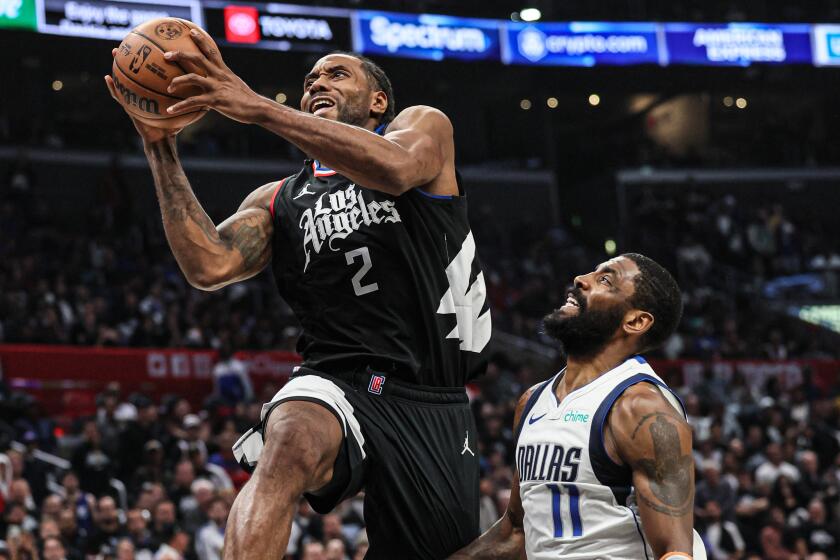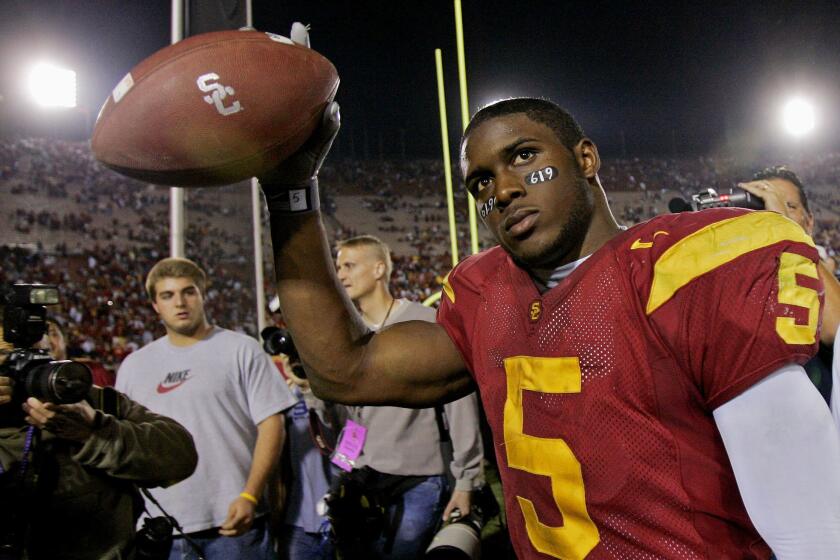She didn’t get it
The words still grind away at Southern California football fans who remember Eric Dickerson high-stepping around would-be tacklers, Henry Ellard breaking free in the end zone and Jack Youngblood terrorizing opposing quarterbacks.
They were uttered moments after the Rams won a Super Bowl representing a city far removed from Los Angeles and Anaheim, words that perfectly summarized Georgia Frontiere’s relationship with Southland sports fans five years after she severed that relationship.
“It proves we did the right thing in going to St. Louis.”
Frontiere’s Rams had just defeated the Tennessee Titans, 23-16, in a Super Bowl played inside the Georgia Dome on Jan. 30, 2000. Frontiere’s Rams. For almost five decades, from 1946 through 1994, fans in Los Angeles and Orange counties felt that team had been their Rams, only to be cruelly introduced to a different reality when Frontiere agreed in January 1995 to move the franchise to St. Louis.
Frontiere, who died Friday at UCLA Medical Center, never truly understood the hearts and minds of the Southland football fans, which is why she never won them. She inherited the Rams when Carroll Rosenbloom, her sixth husband, died in 1979, but never quite grasped that she was in control of much more than just another sports team.
The Rams were a beloved Southern California institution. They were Los Angeles’ first encounter with major league professional sports, arriving in town 12 years before the Dodgers and 14 before the Lakers.
They set high early standards -- winning the NFL championship in 1951, a feat they would not repeat as California residents -- and established a Los Angeles sports template that still holds today:
To make it in L.A., you better win, and you better do so with stars.
Forty-five years before Shaq and Kobe, the Rams had Bob Waterfield and Norm Van Brocklin. Rams home games at the Coliseum were major have-to-be-there events and remained that way through the 1970s, until Rosenbloom announced his intention to move the team to Anaheim before the 1980 season.
Before Rosenbloom could watch his team play a regular-season game in Orange County, he drowned while swimming near his Golden Beach, Fla., home. Rosenbloom’s will left the team to Frontiere, who was clearly unprepared for the responsibility. Local hopes that she would sell the team, or turn the operation over to Rosenbloom’s football-smart son Steve, were quickly dashed when Frontiere fired Steve and hand-picked her own front office.
The move, and ones that soon followed, turned Frontiere into an easy target for fans and media. She wasn’t helped by the calendar; the concept of a woman running a professional sports team was a novelty in 1979. But Frontiere didn’t help herself either. She seemed ill at ease in front of the sports media, which often regarded her as the punch line to just another blond joke, and antagonized fans with public comments that indicated a lack of knowledge of Rams tradition, or sensitivity to fan interests, or both.
When Frontiere moved the Rams to St. Louis, she wasn’t doing anything Rosenbloom hadn’t already done. Rosenbloom wanted a better stadium deal than the Coliseum, found one, and jumped at it. But when Rosenbloom jumped, the Rams traveled 40 miles down the freeway. Frontiere moved the Rams two time zones.
She was also docked for style points. After reaching the 1989 NFC championship game, the Rams spiraled downward throughout the early 1990s, and Frontiere’s front office, led by John Shaw, did nothing to stem the fall. Just the opposite, it seemed Frontiere and Shaw were borrowing the script of “Major League,” intentionally running the team into the ground to drive attendance down to a point where they could rationalize a move from Anaheim.
Frontiere uprooted the Rams the same year Al Davis returned the Raiders to Oakland, 1995, turning once football-glutted Los Angeles into an instant NFL ghost town. But more than a dozen years later, the departure of the Rams and the Raiders are viewed differently.
Davis’ high-tailing it out of town was virtually predictable; he came to L.A. perceived as a carpetbagger, a temporary tenant, biding his time until a better offer materialized. The clock on the Raiders’ Los Angeles residency started ticking the moment the team first arrived in 1982.
The Rams’ heading to St. Louis was considered a civic betrayal. The Rams were not only your parents’ NFL team, they were your grandparents’ team. That connection, that tug, dissipated some when the franchise shifted to Orange County. But fans watching Jim Everett at Anaheim Stadium could still compare and contrast to vivid memories of John Hadl, James Harris and Roman Gabriel.
Other than Walter O’Malley, no owner left a bigger lasting imprint on the Southern California sports landscape than Frontiere. When O’Malley brought the Dodgers west, he sparked Los Angeles’ aspirations to become a top-level professional sports market. When Frontiere took the Rams east, she effectively closed off Los Angeles from the NFL, certainly for the foreseeable future.
When Art Modell took his team from Cleveland to Baltimore, Cleveland eventually got a replacement franchise. The same happened for Houston a few years after Bud Adams moved the Oilers to Tennessee and renamed them the Titans.
More than a dozen years after Frontiere and the Rams left for St. Louis, Los Angeles and Orange counties remain NFL-free zones. That is Frontiere’s legacy here, and as anyone can see at any local football stadium on any NFL Sunday afternoon, it is an empty one.
--
More to Read
Get our high school sports newsletter
Prep Rally is devoted to the SoCal high school sports experience, bringing you scores, stories and a behind-the-scenes look at what makes prep sports so popular.
You may occasionally receive promotional content from the Los Angeles Times.






